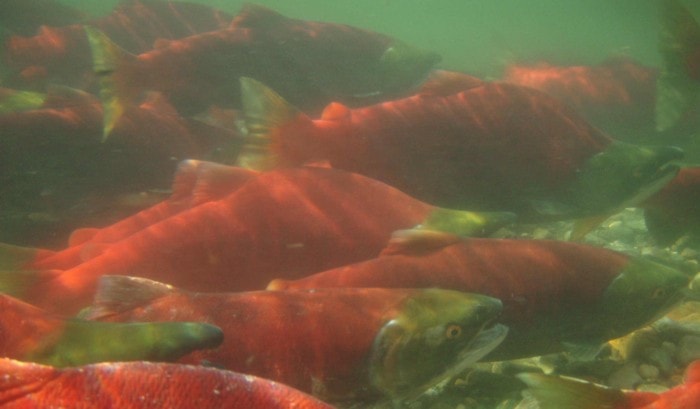Returning sockeye salmon will be tested to determine if this year's run was contaminated by radiation picked up in the North Pacific from Japan's Fukushima nuclear disaster.
The Canadian Food Inspection Agency (CFIA) said sampling of salmon and other fish is already underway and will continue through August and September.
The agency expects the tests, planned since June, will show radiation in B.C.-caught salmon is well below levels that would prompt federal action, but calls it a prudent measure to reaffirm its safety for both domestic and export markets.
"We have tested air quality, domestic milk and foods imported from Japan," CFIA spokesperson Alice D'Anjou said. "No harmful levels of radiation have been detected, and we do not expect this situation to change when fish are tested."
Results are to be posted on the CFIA website as they become available.
Fraser River sockeye migrate far out into the Pacific, as far west as the Bering Sea, although they were likely on their way back to B.C. when multiple Japanese reactors damaged by the March 11 earthquake and tsunami released radiation through the air and contaminated seawater.
Salmon biologist and activist Alexandra Morton supports the testing.
"My feeling is yeah let's check," she said. "A massive amount of radiation was released into the water and air. There's been radiation readings in seaweed in North Vancouver. I do think it should be investigated."
On Aug. 11, Health Canada removed nine extra radiation detectors that had been installed in B.C. and the Yukon in response to the Fukushima disaster, saying radiation levels continue to be within background levels and there's no cause for concern.
An SFU professor who has also gauged radiation levels in B.C. and found nothing of concern supports Ottawa's decision to scale back.
"We haven't seen any increased levels," Kris Starosta said. "Monitoring is very expensive and time consuming."
Claims have circulated on social media this summer that authorities hid the true extent of Canadians' exposure to Japanese radiation.
One recent media report pointed to big "spikes" of Iodine-131 detected by a federal monitoring station at Sidney on Vancouver Island.
For seven days in March, that station did measure Iodine-131 at readings at least 100 times higher than normal, according to Health Canada data.
But Iodine-131 is just one radioisotope and a small component of the overall degree of radiation exposure B.C. residents get from various background sources.
"The resulting dose from any radionuclides detected following the Fukushima event represents only a tiny fraction of the total background radiation dose that Canadians normally receive and does not pose a health risk," Health Canada assistant deputy minister Hilary Geller said in a statement.
A broader measurement of radiation exposure also posted on Health Canada's website show the daily doses measured in March and April at B.C. sites remained roughly in line with the average readings from 2010.
The Burnaby station measured total daily exposures between 0.47 and 0.54 microsieverts in the post-Fukushima weeks, compared to its average 2010 reading of 0.49.
People get much more radiation from a dental X-ray (10 microsieverts), a cross-country jet flight (30 microsieverts) or a CT scan (at least 5,000 microsieverts).
